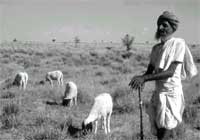The wrath of nature
<p>This film produced by Centre for Science and Environment (CSE) explores increase in flood affected areas in India and analyses the Himalayan floods. It presents an agenda for change and shows how the
<p>This film produced by Centre for Science and Environment (CSE) explores increase in flood affected areas in India and analyses the Himalayan floods. It presents an agenda for change and shows how the

WILL HE go? Will he sign? Will he give money? All these and many more questions on the behaviour of the US President George Bush are threatening to overtake the Earth Summit at Rio. Bush's cat and

Global warming has led to rise in tick borne encephalitis cases
THE meeting of the National Water Resources Council (NWRC), convened by Prime Minister P V Narasimha Rao last month, was a total failure, as no decision was taken on any of the long list of
The natural habitat around the Mount Kenya Forest has been destroyed extensively, reveals a recent Kenya wildlife service survey. Human activity is to be blamed for this large-scale destruction.

Mangroves contribute generously to oceanic carbon

Chairperson designate of the Telecom Commission N Vittal talks to Down To Earth on how he intends to reform the functioning of the commission.

Malaria, prevalent in over 100 countries, poses a risk to some 2,700 million people across the world. Poor health infrastructure and drastic ecological changes have favoured transmission of the malaria parasite, which has developed an immunity even to les
UNDER the unrelenting pressure of population growth, millions of landholdings in Asia and other parts of the developing world are small - and getting smaller. India alone has at least 33

Canadian engineers develop a no effluent discharge technology

Growing grass in the desert of Rajasthan would improve the economy
THIS book is an interesting collection of twelve papers on traditional water harvest ing systems, a much neglected issue in the water policy. The list of authors contribut ing papers to the
Global warming has even increased the temperature of the lithosphere

Panchayat s in Karnataka can now gauge rainfall
<p><strong>Union minister for new and renewable energy, Farooq Abdullah, releases CSE’s Citizen’s Report on State of Renewable Energy</strong></p> <p><strong>In 2012-13, electricity produced
start telling stories: Being a maths wizard and a great storyteller may appear completely different, but a new study by Canada's University of Waterloo suggests that preschool children's

A weather event which Peruvians once regarded as a boon is now recognised as causing terrible global disasters

The key interests of both proponents and opponents of the forest convention is control of the timber market. The convention is driven by commercial interests
Scientists Are Building First Worldwide Portrait Of Human Impact That Has Left Just 4% Of The Seas Pristine In 1980, after college, I joined the crew of a sailboat partway through a circumnavigation of the globe. Becalmed and roasting one day during a 21-day crossing of the western Indian Ocean, several of us dived over the side. Within a few swimming strokes, the bobbing hull seemed a toy over my shoulder as I glanced back through my diving mask. Below me, my shadow and the boat's dwindled to the vanishing point in the two-mile-deep water. Human activity seemed nothing when set against the sea itself. Just a few weeks later, on an uninhabited island in a remote part of the Red Sea, I was proved wrong. The shore above the tide line was covered with old light bulbs, apparently tossed from the endless parade of ships over the years. Now scientists are building the first worldwide portrait of such dispersed human impacts on the oceans, revealing a planet-spanning mix of depleted resources, degraded ecosystems and disruptive biological blending as species are moved around the globe by accident and intent. A paper in the February 15 issue of the journal Science is the first effort to map 17 kinds of human ocean impacts like organic pollution, including agricultural runoff and sewage; damage from bottomscraping trawls; and intensive traditional fishing along coral reefs. About 40% of ocean areas are strongly affected, and just 4% pristine, according to the review. Polar seas are in the pristine category, but poised for change. Some human impacts are familiar, like damage to coral reefs and mangrove forests through direct actions like construction and subtler ones like the loss of certain fish that shape ecosystems. Others were a surprise, said Benjamin S Halpern, the lead author and a scientist at the National Center for Ecological Analysis and Synthesis in Santa Barbara, California. He said continental shelves and slopes proved to be the most heavily affected areas, particularly along densely populated coasts. The most widespread human fingerprint is a slow drop in the pH of surface waters around the world as a portion of the billions of tons of carbon dioxide added to the atmosphere from fuel and forest burning each year is absorbed in water, where it forms carbonic acid. That progressive shift in ocean chemistry could eventually disrupt shell-forming plankton and reef-building species, particularly where other impacts, including rising temperatures from human-caused global warming, create simultaneous stresses, many marine biologists say. "I study this stuff all the time and didn't expect the impacts to be as pervasive as we found,' Halpern said. The review provides a baseline necessary for tracking further shifts, he said. It also identifies some unanticipated trouble spots, similar to terrestrial biodiversity "hot spots' that environmental groups have identified over the years. NYT NEWS SERVICE
TO THE Khasis of Meghalaya, Cherrapunjee, the place receiving the highest rainfall in the world, was known as Sohra. Briti~h administra- tors, who declared it their official state headquarter in